2012 Week 8
Things conspired this week to see that we got less work done than planned. At the start of the week, Wed. – Thurs., the field school was on their annual pilgrimage to Virginia. We were invited to tour the Colonial Williamsburg archaeology lab and to visit two excavations in town. The next day we spent the morning at Historic Jamestown where we saw their excavation and toured the museum and lab. In the afternoon, the students were at the Jamestown Settlement to see the museum and the outdoor exhibits. The staffs of all three institutions were welcoming and gracious and we thank them for their time and patience.
Coming back to the site, the next two days were mostly rained out. We can continue to excavate in light rain but when the ground begins to become muddy, we risk doing serious damage to the site just by working on it. With the end of field school rapidly approaching, we lost two days of working towards the research goals. Which made Sunday all the more special.
Last week I mentioned that we had begun a test unit in the brick cellar but had not found the wall. In between the raindrops, we continued to take the unit down through brick and mortar rubble.
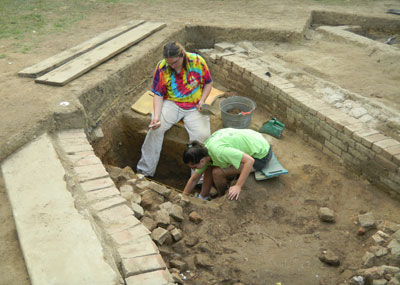
Thomas Barry and Marissa Parlock
excavate the test unit in the brick cellar.
The fill around the rubble was very sandy and had almost nothing in it – very different than the soils that had been over it. Still no brick wall for the cellar. The clay wall of the cellar hole was very straight as we continued to follow the fill down and I began to worry that the wall had been entirely robbed out or never existed at all.
Late on Sunday, we came down on a line of mortar along the back edge of the unit.
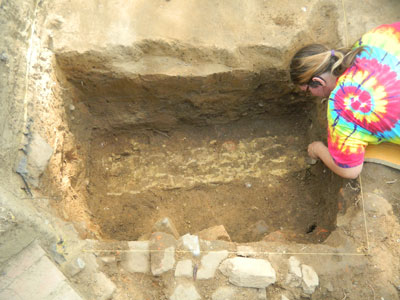
Thomas Barry points to the interior wall of the brick cellar.
This was the top of the surviving cellar wall. It was finally encountered about three feet below where we began excavating the test unit or about five feet below the present surface. While it was a great feeling to have found this feature, like many things in archaeology it provoked more questions than it answered. The wall we found was one brick wide or about 9 inches thick. In contrast, the west walls, and possibly the south wall of the cellar, were one and a half bricks wide or roughly a foot thick. This discrepancy may be due to the west and south walls being on the exterior of the building and therefore having to support the structure. The wall we located, being under the house, could be smaller because it did not have that function.
What is more perplexing is how the wall was built. In the 1980s, when the exterior walls were discovered, they were seen to be laid in English bond. This pattern has alternating rows of headers, the short end of the brick, and stretchers, the long side of the brick, exposed in the wall. It is very commonly used for foundations and fits this area well. Much to our surprise, the interior wall is laid in Flemish bond, a much more decorative bond type. It alternates headers and stretchers in the same row. Why would the interior wall, invisible to anyone but those who enter the cellar, be laid in Flemish bond? It is a question which will not be answered this summer.
While we may not know why this wall was created this way, the fact that it was provides an interesting perspective on the cellar. Flemish bond is very common in the 18th century but rare in the 17th-century Chesapeake. The steps leading to the cellar at St. Peters, in St. Mary’s City, were laid in Flemish bond and date to the late 1670s. A site in Williamsburg, dating to the 1660s, had this bond type and is believed to be the earliest use of it in the Chesapeake. This suggests that at least this wall of the cellar was a later addition and suggests that the brick lined cellar may date to the last part of the 17th century.
Elsewhere on the site, we continued to remove fill over the southern edge of the burned clay cellar and find wonderful artifacts.
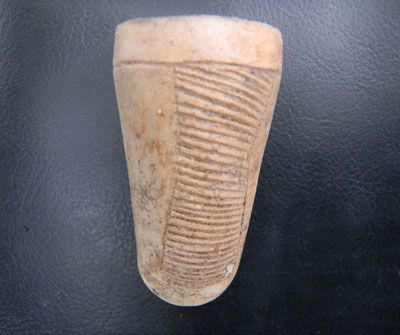
Complete terra cotta pipe bowl with horizontal incised lines.
The photo shows another complete terra cotta pipe bowl from this area. The decoration consists of vertical areas containing incised, horizontal lines. This type of bowl and decoration has been found at the St. Johns site in association with features dating c. 1655-1665. As this particular example was found in the fill that sealed the burned clay cellar, it may indicate an early date for the filling of the cellar.
In the same layer, we found two pieces of lead sprue which were produced from the making of lead shot.
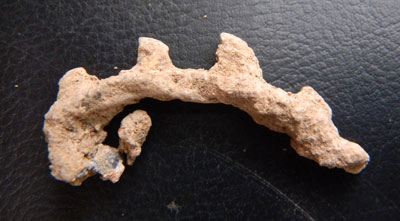
Section of lead sprue from making shot.
Molten lead would be poured into the top of a shot mold and run down a small channel and into the round molds. When cooled, each shot would be cut off the strip. It is surprising that the lead was lost as it could easily have been melted down to make more shot. In addition to the sprue, this area seems to have a significant number of lead shot and English flint. Perhaps the material sealing the cellar came from a cleanup of the site after Ingle’s rebellion in the 1640s.
Another interesting artifact from the fill over the burned clay cellar was a brass spoon handle.
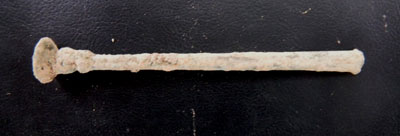
Brass, seal top spoon handle.
This type is called a “seal top spoon” because frequently the flat end would be decorated and could be used to seal letters and documents. In the field, nothing was visible on the seal top but conservation of the object may discover something. These types of spoons developed in England in the 1550s and remained popular up to the 1660s. Like the pipe bowl, this may indicate an early fill date for the cellar.
Below the fill, we exposed a long section of burned clay wall.
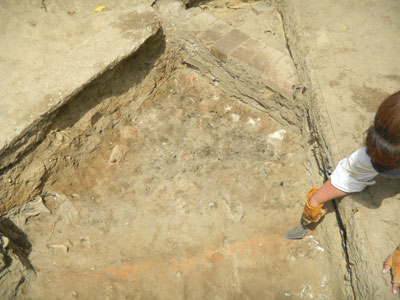
Lissa Tenuta uncovered the burned clay cellar wall.
This can be seen along the lower edge of the photo. The cellar itself is filled with an ashy, charcoal rich layer characterized by large bone fragments. Next week we will begin testing this feature and the anticipation is intense.


